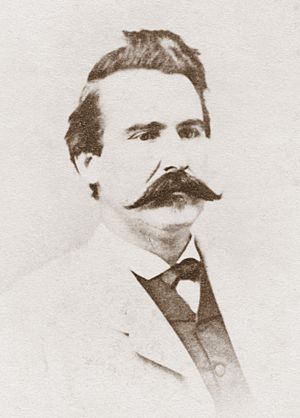Alexander W. Terrell facts for kids
Quick facts for kids
Alexander William Terrell
|
|
|---|---|
 |
|
| Born |
Alexander Watkins Terrell
November 23, 1827 Patrick County, Virginia, U.S.
|
| Died | September 9, 1912 (aged 84) Mineral Wells, Texas, U.S.
|
| Resting place | Texas State Cemetery |
| Alma mater | University of Missouri |
| Occupation | Lawyer, planter, diplomat |
| Spouse(s) | Ann Elizabeth Boulding Sarah D. Mitchell |
| Children | 8 |
| Parent(s) | Christopher Joseph Terrell Susan Kennerly |
| Military career | |
| Allegiance | |
| Service/ |
|
| Years of service | 1863–1865 |
| Unit | 1st Texas Cavalry Regiment 34th Texas Regiment |
| Battles/wars | American Civil War |
Alexander Watkins Terrell (born November 23, 1827 – died September 9, 1912) was an important American figure. He was a lawyer, a judge, and a farmer. He also served as an officer in the Confederate States Army during the American Civil War. Later, he became a diplomat, representing the United States in other countries.
Terrell was the U. S. Envoy to the Ottoman Empire. He helped create important laws, like the Terrell Election Law. He also led the Texas State Historical Association and was on the board of regents for the University of Texas.
Contents
Early Life and Education
Alexander Watkins Terrell was born on November 23, 1827. His birthplace was Patrick County, Virginia. His parents were Christopher Joseph Terrell and Susan Kennerly. His family, who were Quakers, moved to Boonville, Missouri in 1831.
Terrell went to college at the University of Missouri. He finished his studies and became a lawyer in 1849.
Career Highlights
Terrell started his law career in St. Joseph, Missouri. In 1852, he moved to Austin, Texas. He worked as a judge for the district court from 1857 to 1863.
On July 4, 1861, Terrell gave a speech. He spoke at the Texas State Capitol. In his speech, he supported the Southern states leaving the Union. He compared this action to George Washington and the American Revolution.
Military Service
After his time as a judge, Terrell joined the Confederate States Army. He became a major in the First Texas Cavalry Regiment. He fought in several big battles. These included battles during the Red River Campaign and the Battle of Mansfield.
By May 16, 1865, Terrell was given the rank of a brigadier general. This was assigned by General Edmund Kirby Smith. However, this rank was not officially confirmed by the Confederate President.
After the war ended, Terrell went to Mexico. He worked for Emperor Maximilian for a short time. In 1866, he came back to Texas. He started practicing law again in Houston. Later, he spent time managing his farm in Robertson County, Texas.
Political and Diplomatic Roles
After the Reconstruction period, Terrell served in the Texas state government. He was a member of both the Texas Senate and the House of Representatives. He served in the state legislature for sixteen years.
From 1893 to 1897, he was a diplomat. He was the minister plenipotentiary to the Ottoman Empire. This was during U.S. President Grover Cleveland's second term. This means he was a high-ranking representative for the U.S. in that country.
From 1909 to 1911, he was part of the University of Texas board of regents. He also served as the president of the Texas State Historical Association.
Personal Life
Alexander Terrell married Ann Elizabeth Boulding. They had five children together. After she passed away in 1860, he married Sarah D. Mitchell. They had three children.
Death and Legacy
Terrell died on September 9, 1912. He passed away in Mineral Wells, Texas. He was buried at the Texas State Cemetery in Austin, Texas. Terrell County, Texas is named after him to honor his contributions.

